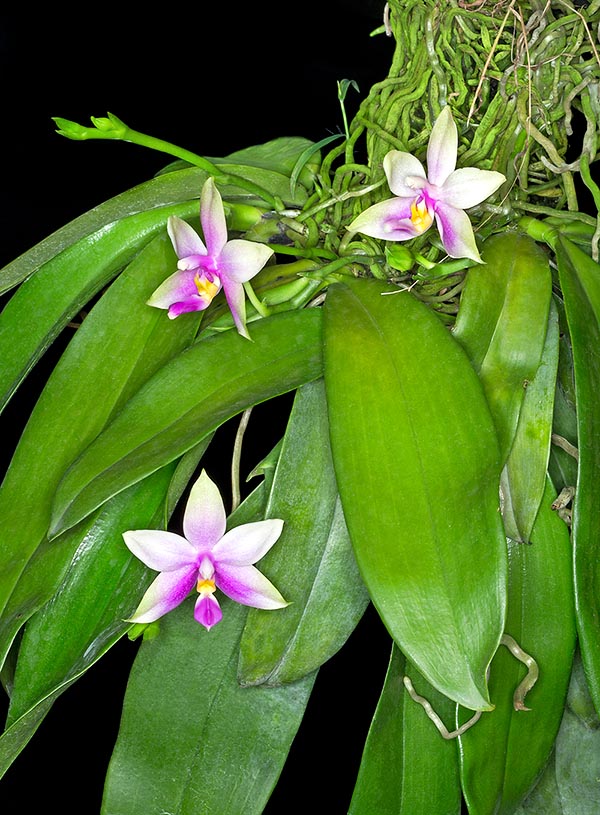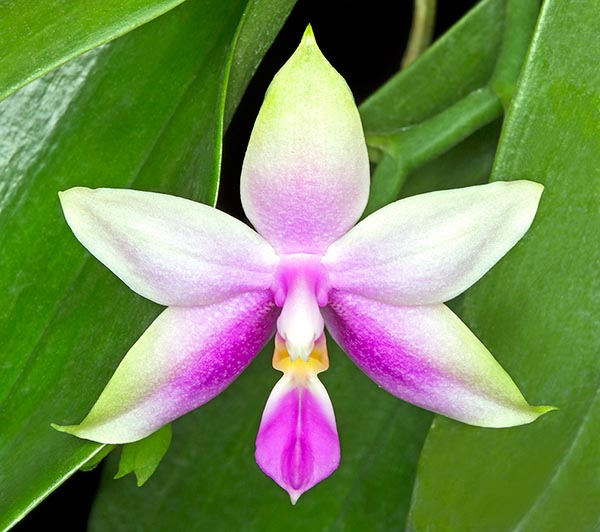Family : Orchidaceae

Text © Pietro Puccio

English translation by Mario Beltramini

Epiphyte of Peninsular Malaysia and Sumatra, Phalaenopsis violacea has short stem, hidden by fleshy and imbricate 15-25 cm elliptic to oblong-elliptic leaves, that can be also 12 cm broad © Giuseppe Mazza
The generic name is the combination of the Greek substantives “φάλαινα” (phalaina) = butterfly and “ὄψις” (opsis) = look, with obvious reference; the specific name is the Latin adjective “violaceus, a, um” = violaceous, with reference to the colour of the flowers.
Common names: violet moth orchid, violet phalaenopsis (English).
The Phalaenopsis violacea H.Witte (1861) is an epiphytic species with short stem, wholly hidden by the imbricate foliar bases, and elliptic to oblong-elliptic leaves, 15-25 cm long and 7-12 cm broad, fleshy, of intense green colour and glossy above. Rather short lateral inflorescences with flat rachis bearing waxy flowers, pleasantly scented, of 4-7 cm of diameter, opening gradually 1-2 at a time, with sepals and petals of pale greenish colour suffused of violaceous at the base, more intense in the lower half of the lateral sepals and labellum with purple violaceous median lobe and lateral lobes yellow at the base and violaceous at the apex; in nature do exist entirely white individuals with greenish shades at the apices of sepals and petals. Oblong sepals with pointed apex, 2-3,5 cm long and 1-1,5 cm broad, ovate-elliptic petals, 2-3 cm long and 0,7-1,7 cm broad, trilobed labellum, 1,8-2,6 cm long and 0,8-1 cm broad, with oblong lateral lobes having truncated apex, 0,7 cm long, curved until they touch, and obovate median lobe with pointed and fleshy apex.
One of the most cultivated and used in the hybridizations Phalaenopsis due to the beauty and the scent of its long lasting flowers, about one month, requires a shaded position, medium-high temperatures, 20-30 °C, with night lowest values in winter not under the 18 °C, high atmospheric humidity, 75-85%, and constantly moving air. The waterings and the nebulizations must be regular, preferably in the first half of the day in order to allow the plant to be dry for the night, in particular at the axil of the leaves, being sensitive to rottenness, utilizing rain water, demineralized or by reverse osmosis. In a flat, where the humidity is far away from the required values, this may be increases with frequent nebulizations with water at ambient temperature or placing the plant over a wide flowerpot saucer filled with gravel or expanded clay with a layer of water not in direct contact with the plant, so to create around it a humid microclimate.

Seriously menaced in nature due to its beauty, is one of the most appreciated Phalaenopsis due to the scented long lasting flowers up to 7 cm broad. Has originated several hybrids cultivable also at home © Giuseppe Mazza
Biweekly fertilizations utilizing a balanced hydrosoluble manure, with microelements, at ¼ the dosage suggested on the package. The repottings are to be done only when the substratum has decomposed and by the vegetative restart. The floral stem is to be cut when completely dry, as it can bloom again for various years.
Due to the reduction of its habitat and the indiscriminate harvesting, its population has strongly reduced so much to be inserted into the red list of the IUCN (International Union for the Conservation of Nature and Natural Resources) as “Vulnerable” (species at risk of extinction in nature).
The species is reported in the appendix II of CITES (species whose trade is internationally ruled).
Synonyms: Phalaenopsis violacea var. alba Teijsm. & Binn. (1862); Stauritis violacea (H.Witte) Rchb.f. (1862); Stauropsis violacea (H.Witte) Rchb.f. (1862); Polychilos violacea (H.Witte) Shim (1982); Phalaenopsis violacea f. alba (Teijsm. & Binn.) Christenson (2001); Phalaenopsis violacea f. coerulea Christenson (2001).
→ For general notions about ORCHIDACEAE please click here.
